Birth name Jean Reinhardt Name Django Reinhardt Role Guitarist | Instruments Guitar Movies Jazz Hot Years active 1928–53 | |
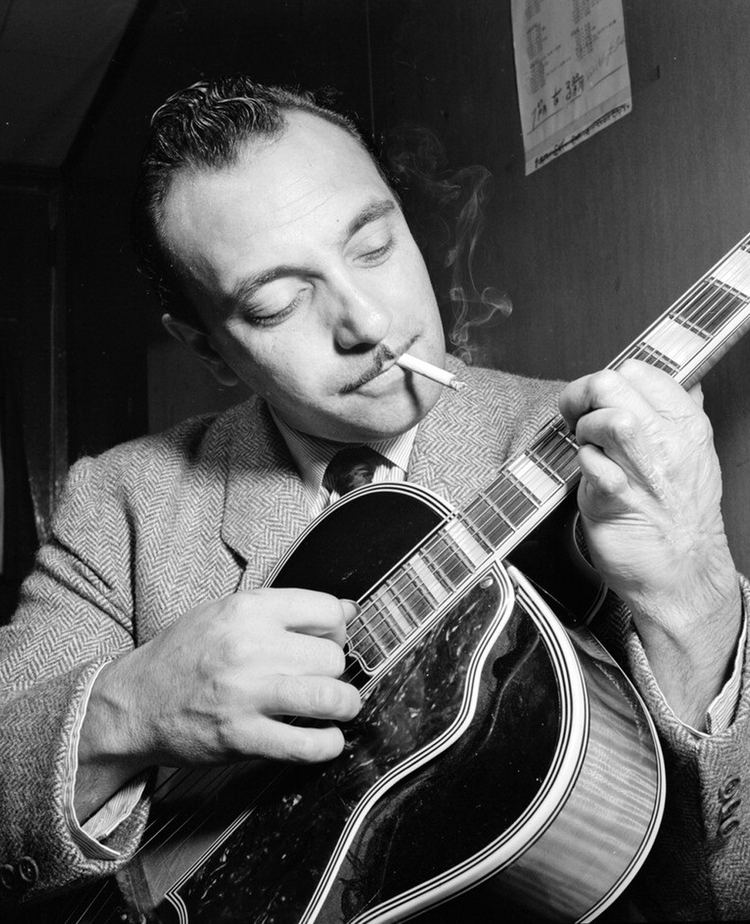 | ||
Albums Django Reinhardt / Stephane, Djangology, Django Reinhardt et le Quin, Three Fingered Lightning, The Classic Early Rec | ||
Occupation(s) Guitarist, composer | ||
Django Reinhardt & Stéphane Grappelli - Jattendrai Swing 1939 - LIVE!
Jean "Django" Reinhardt ([dʒãŋɡo ʁɛjnaʁt] or [dʒɑ̃ɡo ʁenɑʁt]; 23 January 1910 – 16 May 1953) was a Belgian-born, Romani French jazz guitarist and composer, regarded as one of the greatest musicians of the twentieth century. He was the first jazz talent to emerge from Europe and remains the most significant by far.
Contents
- Django Reinhardt Stphane Grappelli Jattendrai Swing 1939 LIVE
- Street musician trafalgar square london guitar django reinhardt
- Early life
- Marriage and injury
- Discovery of jazz
- Formation of the quintet
- World War II
- United States tour
- After the quintet
- Final years
- Family
- Legacy
- Tributes
- Influence
- Reinhardt in popular culture
- Releases in his lifetime
- Posthumous compilations LP cassette and CD
- Unrecorded compositions
- References
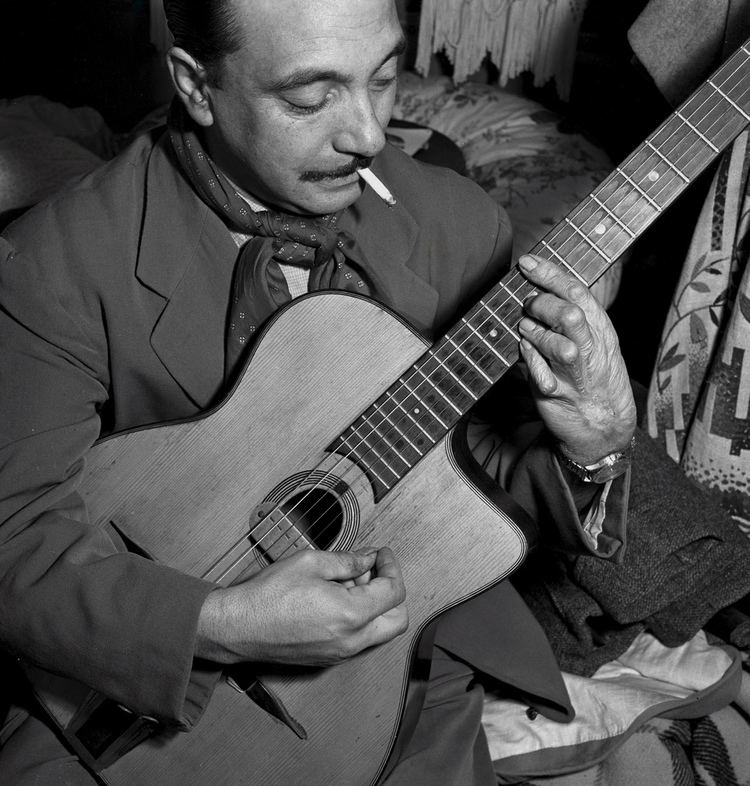
Reinhardt lost most control of two fingers on his left hand in a fire in his youth. He developed a modified technique to overcome this disability and went on to forge an entirely new 'hot' jazz guitar style, now known as Gypsy jazz, or jazz manouche, that remains a musical tradition in France and neighbouring countries—especially within Gypsy culture. Reinhardt's innovations on the guitar helped elevated it above its prior position as usually only a rhythm instrument.
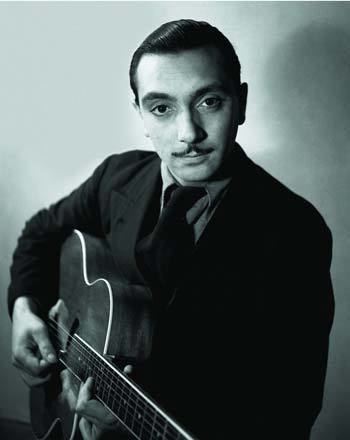
With violinist Stéphane Grappelli, Reinhardt formed the Paris-based Quintette du Hot Club de France in 1934. The group was among the first to play jazz that featured the guitar as a lead instrument. Reinhardt recorded in France with many visiting American musicians, including Coleman Hawkins and Benny Carter, and briefly toured the United States with Duke Ellington's orchestra in 1946. He died suddenly of a stroke at the age of 43.
Reinhardt's most popular compositions have become standards within gypsy jazz, including Minor Swing, Daphne, Belleville, Djangology, Swing '42, and Nuages. Jazz guitarist Frank Vignola claims that nearly every major popular-music guitarist in the world has been influenced by Reinhardt. Over the last few decades, annual Django festivals have been held throughout Europe and the U.S., and a biography has been written about his life. In February 2017, the Berlin International Film Festival held the world premiere of the French film, Django.
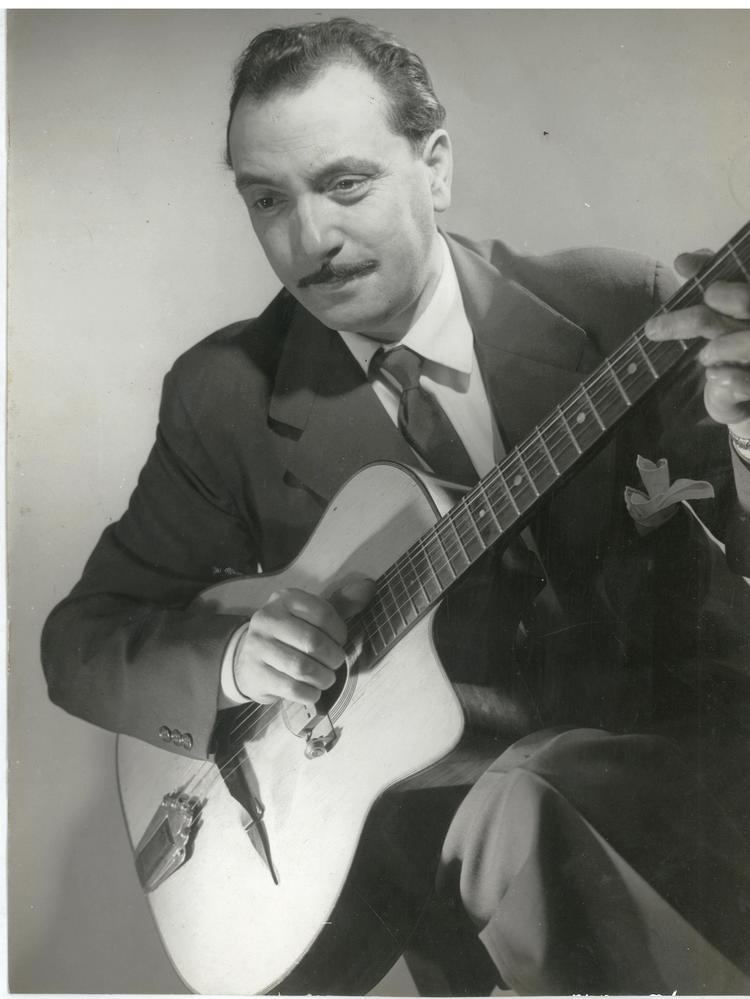
Street musician trafalgar square london guitar django reinhardt
Early life

Reinhardt was born on 23 January 1910 in Liberchies, Pont-à-Celles, Belgium, into a Belgian family of Manouche Romani descent. His father was Jean Eugene Weiss, but domiciled in Paris with his wife, he went by Jean-Baptiste Reinhardt, his wife's surname, to avoid French military conscription. His mother, Laurence Reinhardt, was a dancer. The birth certificate refers to "Jean Reinhart, son of Jean Baptiste Reinhart, artist, and Laurence Reinhart, housewife, domiciled in Paris".

A number of authors have repeated the claim that Reinhardt's nickname, Django, is Romani for "I awake.", however it may also simply have been a diminutive, or local Walloon version, of "Jean". Reinhardt spent most of his youth in Romani encampments close to Paris, where he started playing the violin, banjo, and guitar. He became adept at stealing chickens, which was viewed as a noble skill by the Romani, because part of their means of survival on the road was to steal from the non-Gypsy world around them. His father reportedly played music in a family band comprising himself and seven brothers; a surviving photograph shows this band including his father on piano.
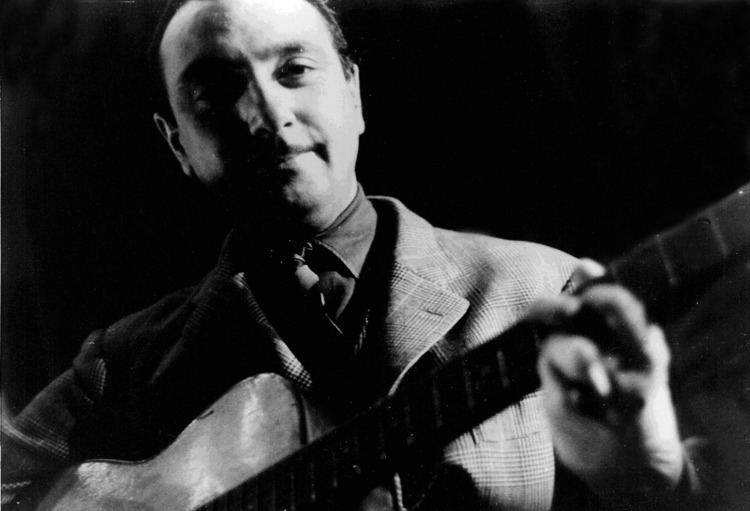
Reinhardt was attracted to music at an early age, first playing the violin. At the age of 12 he received a banjo-guitar as a gift. He quickly learned to play, mimicking the fingerings of musicians he watched, who would have included local virtuoso players of the day such as Jean "Poulette" Castro and Auguste "Gusti" Malha, as well as from his uncle Guiligou, who played violin, banjo and guitar. Reinhardt was able to make a living playing music by the time he was 15. He received little formal education and acquired the rudiments of literacy only in adult life.
Marriage and injury
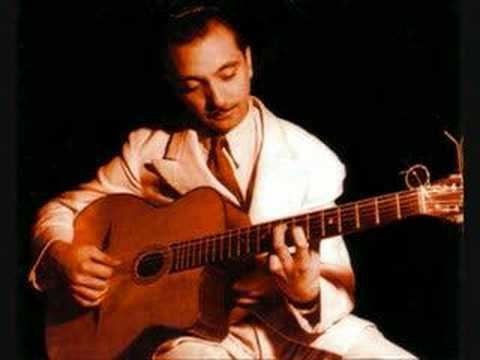
At the age of 17 Reinhardt married Florine "Bella" Mayer, a girl from the same gypsy settlement, according to gypsy custom (although not an official marriage under French law). The following year he recorded for the first time. On these recordings, made in 1928, Reinhardt plays the "banjo" (actually the banjo-guitar) accompanying the accordionists Maurice Alexander, Jean Vaissade and Victor Marceau, and the singer Maurice Chaumel. His name was now drawing international attention, such as from British bandleader Jack Hylton, who came to France just to hear him play. He offered him a job on the spot, and Reinhardt accepted.
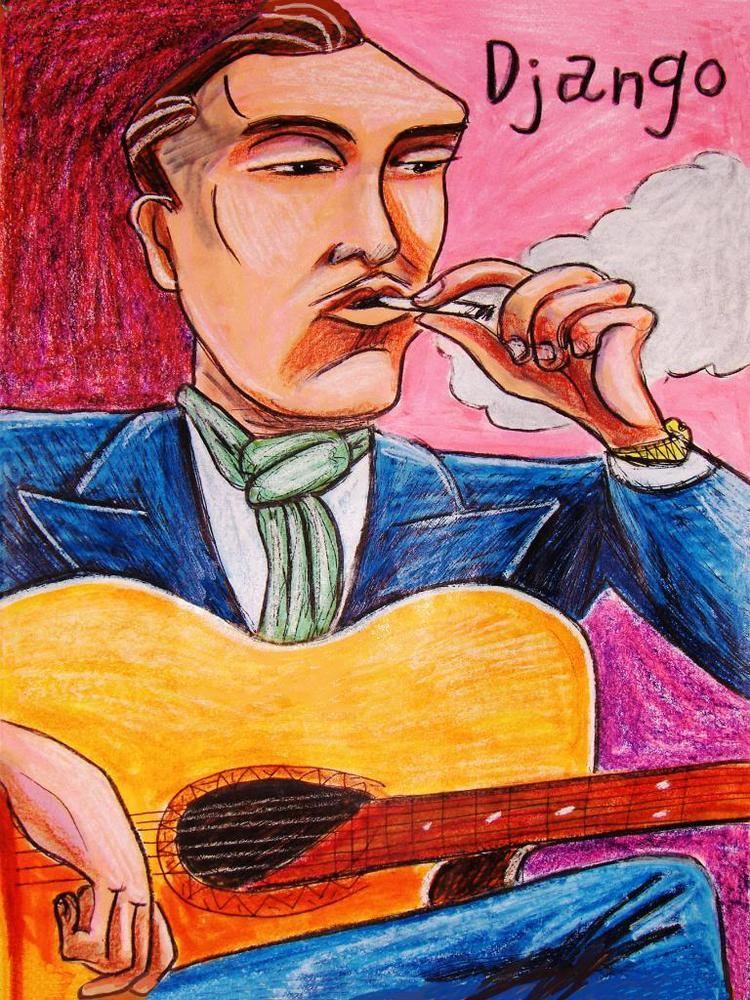
Before he had a chance to start with the band, however, he nearly lost his life when the caravan he and his wife lived in caught fire when he knocked over a candle on his way to bed. His wife made artificial flowers from extremely flammable celluloid. They caught fire, engulfing the wagon in flames almost immediately. Reinhardt dragged himself and his wife through the fire to safety, but suffered extensive burns on his left hand and other areas. He received first- and second-degree burns over half his body. His right leg was paralyzed, and the fourth and fifth fingers of his left hand were badly burned. Doctors believed that he would never play guitar again, and they intended to amputate one of his legs. Reinhardt refused to have the surgery and left the hospital after a short time; he was able to walk within a year with the aid of a cane.
Two of his fingers remained paralyzed. By sheer will, he taught himself to overcome his now permanent handicap by using only his thumb and two fingers. In 1929, his wife gave birth to a son, Henri "Lousson" Reinhardt. As a result of the trauma and injuries, he and Bella parted company soon after. His son later took the surname of his mother's new husband, Baumgartner. He later recorded with Django.
His brother, Joseph Reinhardt, also an accomplished guitarist, bought Reinhardt a new guitar. With rehabilitation and practice, he re-learned his craft in a completely new way. He played all his guitar solos with only the index and middle fingers and used the two injured fingers only for chord work.
Discovery of jazz
The years between 1925 and 1933 were formative for Reinhardt, personally and musically. He had parted with his wife and had formed a relationship with one of his distant cousins, Sophie Ziegler, nicknamed "Naguine." They traveled throughout France with Reinhardt getting occasional jobs playing at small clubs. He had no definite goals, living a hand-to-mouth existence. The concept of money and saving was foreign to him, and he spent his earnings as quickly as he made them.
One change during this period was his abandonment of the banjo in favor of the guitar. He was playing all types of music previously but began to appreciate American jazz a little during this period, when an acquaintance, Émile Savitry, played him a number of records from his collection. It was the first time Reinhardt heard leading American jazz musicians, such as Louis Armstrong and Duke Ellington. The new sounds gave Reinhardt a vision and goal of becoming a jazz professional.
He later met Stéphane Grappelli, a young violinist with similar musical interests. In the absence of paid work in their radical new music, the two would jam together, along with a loose circle of other musicians. Finally, Reinhardt acquired his first Selmer guitar in the mid-1930s. He used the volume and expressiveness of the instrument as integral elements of his style.
Formation of the quintet
From 1934 until the outbreak of World War II in 1939, Reinhardt and Grappelli worked together as the principal soloists of their newly formed Hot Club, in Paris. It became the most accomplished and innovative European jazz group of the period.
Reinhardt's brother Joseph and Roger Chaput also played on guitar, and Louis Vola was on bass. The Quintette was one of the few well-known jazz ensembles composed only of stringed instruments.
In Paris on 14 March 1933, Reinhardt recorded two takes each of "Parce-que je vous aime" and "Si, j'aime Suzy", vocal numbers with lots of guitar fills and guitar support. He used three guitarists along with an accordion lead, violin, and bass. In August 1934, he made other recordings with more than one guitar (Joseph Reinhardt, Roger Chaput, and Reinhardt), including the first recording by the Quintette. In both years the great majority of their recordings featured a wide variety of horns, often in multiples, piano, and other instruments, but the all-string instrumentation is the one most often adopted by emulators of the Hot Club sound.
Decca Records in the United States released three records of Quintette songs with Reinhardt on guitar, and one other, credited to "Stephane Grappelli & His Hot 4 with Django Reinhardt", in 1935.
Reinhardt also played and recorded with many American jazz musicians, such as Adelaide Hall, Coleman Hawkins, Benny Carter, and Rex Stewart (who later stayed in Paris). He participated in a jam session and radio performance with Louis Armstrong. Later in his career, Reinhardt played with Dizzy Gillespie in France. Also in the neighborhood was the artistic salon R-26, at which Reinhardt and Grappelli performed regularly as they developed their unique musical style.
In 1938 Reinhardt's quintet played to thousands at an all-star show held in London's Kilburn State auditorium. While playing, he noticed American film actor Eddie Cantor in the front row. When their set ended, Cantor rose to his feet, then went up on stage and kissed Reinhardt's hand, paying no concern to the audience. A few weeks later the quintet played at the London Palladium.
World War II
When World War II broke out, the original quintet was on tour in the United Kingdom. Reinhardt returned to Paris at once, leaving his wife in the UK. Grappelli remained in the United Kingdom for the duration of the war. Reinhardt re-formed the quintet, with Hubert Rostaing on clarinet replacing Grappelli.
In 1943, Reinhardt married Sophie "Naguine" Ziegler in Salbris. They had a son, Babik Reinhardt, who later became a respected guitarist in his own right. Thanks to his superior music talent, Reinhardt would survive the war unscathed, unlike many Gypsies who were interned and killed in the Porajmos, the Nazi regime's systematic murder of several hundred thousand European Gypsies.
In addition, the German attitude toward jazz from the time of World War I had been one of general hostility. Between 1916 and 1920 all jazz was banned in Germany. From 1922 on, jazz was mostly suppressed, and after 1933 Hitler banned most jazz, which he and his minister, Goebbels, felt was part of an international conspiracy to undermine Germany's greatness. It would not be until the mid-1950s that Germany reopened itself to European jazz.
But beginning in 1933, all German Gypsies were doomed, states Dregni. They were barred from living in cities and were herded into settlement camps. Nazi doctors began sterilizing them, and like the yellow Stars of David that Jews had to subsequently wear, Gypsies were required to wear a brown Gypsy ID triangle sewn on their chest. By 1942, Gypsies and Jews were systematically being killed at new camps such as Auschwitz. Other Gypsies, such as those in France, were used as slave labor on farms and factories. Some 600,000 Gypsies throughout Europe were eventually killed.
Because Reinhardt and his family were Gypsies, and he was also a jazz musician, he tried to escape from occupied France with his family. After his first attempt, he survived when a secretly jazz-loving German, Luftwaffe officer Dietrich Schulz-Köhn, let him go back to France after he was captured. But still desperate to get out of France, knowing that Gypsies were being rounded up and killed in concentration camps, he tried again to cross into Switzerland a few days later, this time in the dead of night. But he was stopped by Swiss border guards who forced him to return to Paris.
During the occupation of France, Reinhardt continued playing and composing. One of his songs, "Nuages," became an unofficial anthem in Paris to signify hope for liberation. During a concert at the Salle Pleyel, the popularity of the song was such that the crowd made him replay the song three times in a row. The 78 of the song sold over 100,000 copies.
Since the Nazis officially disapproved of jazz, Reinhardt tried to develop other musical directions. He tried to write a Mass for the Gypsies and a symphony (he worked with an assistant to notate what he was improvising). His modernist piece Rhythm Futur was intended to be acceptable.
United States tour
After the war, Reinhardt rejoined Grappelli in the UK. In the autumn of 1946, he made his first tour in the United States, debuting at Cleveland Music Hall as a special guest soloist with Duke Ellington and His Orchestra. He played with many notable musicians and composers, such as Maury Deutsch. At the end of the tour, Reinhardt played two nights at Carnegie Hall in New York City; he received a great ovation and took six curtain calls on the first night.
Despite his pride in touring with Ellington (one of two letters to Grappelli relates his excitement), he was not fully integrated into the band. He played a few tunes at the end of the show, backed by Ellington, with no special arrangements written for him. After the tour, Reinhardt secured an engagement at Café Society Uptown, where he played four solos a day, backed by the resident band. These performances drew large audiences. Having failed to bring his usual Selmer Modèle Jazz, he played on a borrowed electric guitar, which he felt hampered the delicacy of his style. He had been promised jobs in California, but they failed to develop. Tired of waiting, Reinhardt returned to France in February 1947.
After the quintet
After his return, Reinhardt re-immersed himself in Gypsy life, finding it difficult to adjust to the postwar world. He sometimes showed up for scheduled concerts without a guitar or amplifier, or wandered off to the park or beach. On a few occasions he refused to get out of bed. Reinhardt developed a reputation among his band, fans, and managers as extremely unreliable. He skipped sold-out concerts to "walk to the beach" or "smell the dew." During this period he continued to attend the R-26 artistic salon in Montmartre, improvising with his devoted collaborator, Stéphane Grappelli.
In Rome in 1949, Reinhardt recruited three Italian jazz players (on bass, piano, and snare drum) and recorded over 60 tunes in an Italian studio. He united with Grappelli, and used his acoustic Selmer-Maccaferri. The recording was issued for the first time in the late 1950s.
Back in Paris, in June 1950, Reinhardt was invited to join an entourage to welcome the return of Benny Goodman. He also attended a reception for Goodman, who after the war ended had asked Reinhardt to join him in the U.S. He asked him again, and out of politeness, Reinhardt agreed. But he later had second thoughts about what role he could play alongside Goodman, who was the "King of Swing," and remained in France.
Final years
In 1951, Reinhardt retired to Samois-sur-Seine, near Fontainebleau, where he lived until his death. He continued to play in Paris jazz clubs and began playing electric guitar. (He often used a Selmer fitted with an electric pickup, despite his initial hesitation about the instrument.) In his final recordings, made with his Nouvelle Quintette in the last few months of his life, he had begun moving in a new musical direction, in which he assimilated the vocabulary of bebop and fused it with his own melodic style.
While walking from the Avon railway station after playing in a Paris club, he collapsed outside his house from a brain hemorrhage. It was a Saturday and it took a full day for a doctor to arrive. Reinhardt was declared dead on arrival at the hospital in Fontainebleau, at the age of 43.
Family
Reinhardt's second son, Babik, became a guitarist in the contemporary jazz style. His first son, Lousson, was more of a traditionalist. He followed the Romani lifestyle and rarely performed in public. After Reinhardt died, his brother Joseph at first swore to abandon music, but he was persuaded to perform and record again. Joseph's son Markus Reinhardt is a violinist in the Romani style.
A third generation of direct descendants has developed as musicians: David Reinhardt, Reinhardt's grandson (by his son Babik), leads his own trio. Dallas Baumgartner, a great-grandson by Lousson, is a guitarist who travels with the Romani and keeps a low public profile. A slightly younger distant relative, violinist Schnuckenack Reinhardt, became famous in Germany as a performer of gypsy music and gypsy jazz up to his death in 2006, and also assisted in keeping Reinhardt's legacy alive through the period following his death.
Legacy
Django Reinhardt, born in a trailer and part of a gypsy nomadic culture, is regarded as one of the greatest guitar players of all time, and the first important European jazz musician to make a major contribution with jazz guitar. During his career he wrote nearly 100 songs, according to jazz guitarist Frank Vignola
Using a Selmer Guitar in the mid-1930s, his style took on new volume and expressiveness. Despite his handicap after a fire that damaged his third and fourth fingers, he played mainly using his index and middle fingers, and invented a distinctive style of jazz guitar.
For about a decade after Reinhardt's death, interest in his musical style was minimal. In the fifties, bebop superseded swing in jazz, rock and roll took off, and electric instruments became dominant in popular music. Since the mid-sixties, there has been a revival of interest in Reinhardt's music, a revival that has extended into the 21st century, with annual festivals and periodic tribute concerts. His devotees included classical guitarist Julian Bream and country guitarist Chet Atkins, who considered him one of the ten greatest guitarists of the twentieth century.
The Allman Brothers Band song "Jessica" was written by Dickey Betts in tribute to Reinhardt. Woody Allen's 1999 film Sweet and Lowdown, the story of a Django Reinhardt-like character, mentions Reinhardt and includes actual recordings in the film. "Django was the definitive genius on the guitar, and the depth of his gift was so spectacular," says Allen.
Among the reasons for the delayed recognition of Reinhardt in the U.S. was because until recently the guitar was not considered a jazz instrument, unlike the piano or horn. Recording artist David Grisman states that there was a "prejudice against anything that's different in jazz, and playing jazz on stringed instruments is just too different." Reinhardt's five-piece band initially played only strings, with three guitarists, a violinist and a bass player. Guitarist Mike Peters notes that "the word 'genius' is bantered about too much. But in jazz, Louis Armstrong was a genius, Duke Ellington was another one, and Reinhardt was also." Grisman adds, "As far as I'm concerned, no one since has come anywhere close to Django Reinhardt as an improviser or technician."
The popularity of gypsy jazz has generated an increasing number of festivals, such as the Festival Django Reinhardt held every last weekend of June since 1983 in Samois-sur-Seine (France), the various DjangoFests held throughout Europe and the USA, and Django in June, an annual camp for Gypsy jazz musicians and aficionados.
Tributes
In February 2017, the Berlin International Film Festival would hold the world premiere of Django (2017), a French film directed by Etienne Comar. The movie covers Django's escape from Nazi-occupied Paris in 1943 and the fact that even under "constant danger, flight and the atrocities committed against his family," he continued composing and performing. Reinhardt's music was re-recorded for the film by the Dutch jazz band Rosenberg Trio with lead guitarist Stochelo Rosenberg.
The documentary film, Djangomania! was released in 2005. The hour-long film was directed and written by Jamie Kastner, who traveled throughout the world to show the influence of Django's music in various countries.
In 1984 the Kool Jazz Festival, held in Carnegie Hall and Avery Fisher Hall, was dedicated entirely to Reinhardt. Performers included Grappelli, Benny Carter, and Mike Peters with his group of seven musicians. The festival was organized by George Wein.
Jazz guitarist Bucky Pizzarelli from New Jersey performed a tribute concert in 2001.
In 2010, to celebrate Reinhardt's 100th birthday, guitarist Frank Vignola and his Hot Club paid tribute with a concert in Rock Hall, Maryland.
In 2011 French jazz guitarist and violinist Dorado Schmitt and an all-star ensemble held concerts named "The Spirit of Django," at Segerstrom Center for the Arts near Los Angeles.
Influence
Many guitar players and other musicians have expressed admiration for Reinhardt or have cited him as a major influence. Jeff Beck described Reinhardt as "by far the most astonishing guitar player ever" and "quite superhuman". Beck recalls that he once came across a rare black-and-white film of Django playing:
"It's the most glorious, but tantalizing short footage, but he is playing like crazy. I've been studying it in slow motion, and all you can see are these two grubby fingers going like lightning up and down the fretboard."
Grateful Dead's Jerry Garcia and Black Sabbath's Tony Iommi, both of whom lost fingers in accidents, were inspired by Reinhardt's example of becoming an accomplished guitar player despite his injuries. Garcia was quoted in June 1985 in Frets Magazine:
His technique is awesome! Even today, nobody has really come to the state that he was playing at. As good as players are, they haven’t gotten to where he is. There's a lot of guys that play fast and a lot of guys that play clean, and the guitar has come a long way as far as speed and clarity go, but nobody plays with the whole fullness of expression that Django has. I mean, the combination of incredible speed – all the speed you could possibly want – but also the thing of every note have a specific personality. You don’t hear it. I really haven’t heard it anywhere but with Django.
Reinhardt in popular culture
Releases in his lifetime
Reinhardt recorded over 900 sides in his recording career, from 1928 to 1953, the majority as sides of the then-prevalent 78-RPM records, with the remainder as acetates, transcription discs, private and off-air recordings (of radio broadcasts), and part of a film soundtrack. Only one session (eight tracks) from March 1953 was ever recorded specifically for album release by Norman Granz in the then-new LP format, but Reinhardt died before the album could be released. In his earliest recordings Reinhardt played banjo (or, more accurately, banjo-guitar) accompanying accordionists and singers on dances and popular tunes of the day, with no jazz content, whereas in the last recordings before his death he played amplified guitar in the bebop idiom with a pool of younger, more modern French musicians. A full chronological listing of his lifetime recorded output is available from the source cited here, and an index of individual tunes is available from the source cited here. A few fragments of film performance (without original sound) also survive, as does one complete performance with sound, of the tune "J'Attendrai" performed with the Quintet in 1938 for the short film Le Jazz Hot.
Posthumous compilations (LP, cassette and CD)
Reinhardt's recorded output has been re-released on a large number of LPs, cassettes and CDs since his death and also the start of the LP era. Of particular mention is Intégrale Django Reinhardt, volumes 1–20 (40 CDs), released by the French company Frémeaux from 2002 to 2005, which strove to include every known track on which he played.
The following list of reissues is only a selection; as at December 2015, www.discogs.com listed more than 560 such albums; a full listing is available from the source cited here.
Unrecorded compositions
A small number of waltzes composed by Reinhardt in his youth were never recorded by the composer, but were retained in the repertoire of his associates and several are still played today. They came to light via recordings by Matelo Ferret in 1960 (the waltzes "Montagne Sainte-Genevieve", "Gagoug", "Chez Jazquet" and "Choti"; Disques Vogue (F)EPL7740) and 1961 ("Djalamichto" and "En Verdine"; Disques Vogue (F)EPL7829). The first four are now available on Matelo's CD Tziganskaïa and Other Rare Recordings, released by Hot Club Records (subsequently reissued as Tziganskaïa: The Django Reinhardt Waltzes). Django also worked on composing a Mass for use by the gypsies, which was not completed although an 8 minute extract exists, played by the organist Léo Chauliac for Reinhardt's benefit, via a 1944 radio broadcast; this can be found on the CD release "Gipsy Jazz School" and also on volume 12 of the "Intégrale Django Reinhardt" CD compilation.
